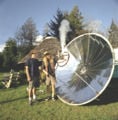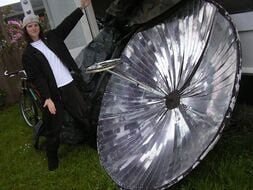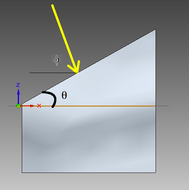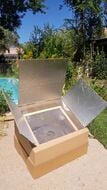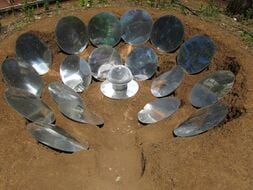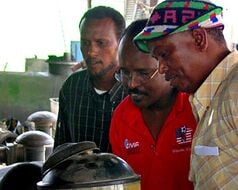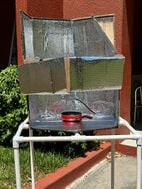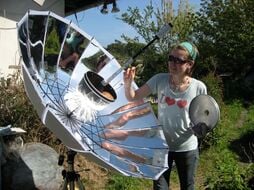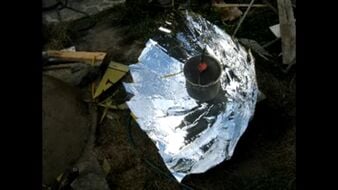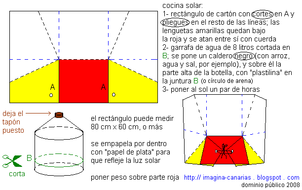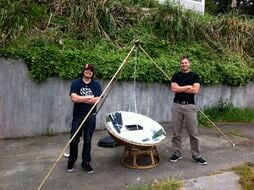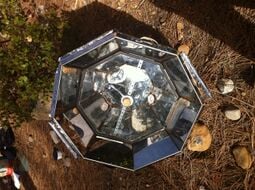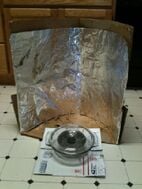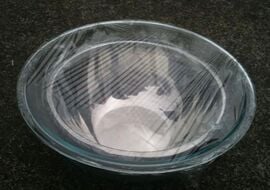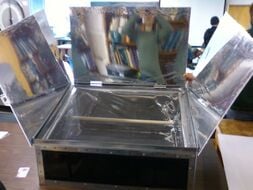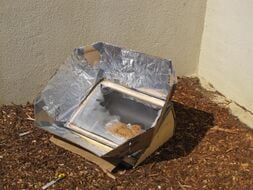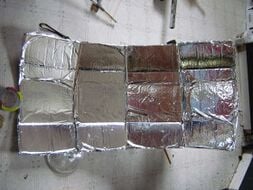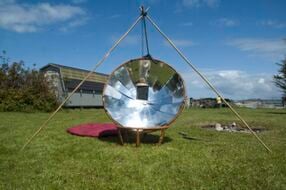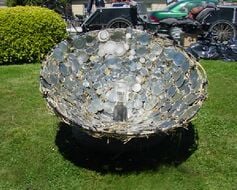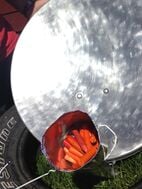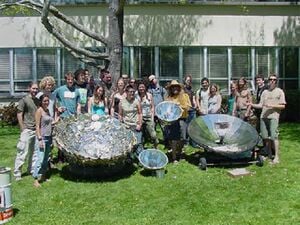
Several engineers and DIY enthusiasts have designed literally hundreds of different types of solar cookers; from simple designs like the solar bowling oven to more complicate ones like the parabolic basket and tin can solar cooker. This expansive variety of options makes it difficult to standardize and evaluate solar cookers, however some critical factors must be met for a design to be successful, some of which are listed below: Cost - must be cheap enough to be viable for implementation into rural areas.
- Convenience - can be built by readily available local materials in a short period of time, as well as being light-weight.SOL
- Safety - heated area must be well protected and no parts should be jutting out.
- Efficiency - how long will it take to cook the food?
- Wind resistance - must be sturdy enough to not be affected by light to moderate winds.
- Heating capacity - sufficient heating capacity based on it's use (water pasteurization vs. cooking food).
- Durability - repairs should be infrequent and easily performed.
- Simplicity of instructions.
The requirements for solar cooking are very simple. You must be able to place the solar cooker in a location that gets sun for several hours and be protected from strong wind. Solar cookers, obviously do not work at night or on very cloudy days. The sunlight is absorbed on dark surfaces that heat up. Food cooks best in dark, shallow, thin metal pots with dark, tight-fitting lids to hold in heat and moisture. To retain the heat created when the black pot absorbs the suns rays some form of transparent cover is needed. This can be as simple as a clear plastic bag or as complicated as evacuated multiple layers of glass. One method to speed the cooking process is to use reflectors to increase the concentration of sunlight on your collector.
Developmental need[edit | edit source]
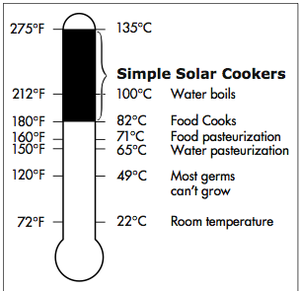
Cooking in developing countries is customarily done on open fires using biomass such as firewood, charcoal, and kerosene. This process inevitably leads to excessive deforestation in these rural regions as well as considerably increase CO2 emissions. Individuals in these developing regions also suffer from respiratory infections due to significant smoke inhalation.
About 5 million children in the developing world die each year from respiratory ailments and a further 5 million are estimated to die from diseases associated with contaminated drinking water.[2] These figures can hope to be partially reduced using solar cooking technology.
Solar cookers work on the basic principle of sunlight being converted to thermal energy that is retained and used for outdoor cooking purposes, and have the most positive impact in sunny, fuel-scarce regions of the world. An optimistic estimate states that solar cooking could cause a potential reduction of fuelwood use by 36% which corresponds to approximately 246 million metric tons of wood each year, thus resulting in a net greenhouse gas offset of nearly 140 million metric tons per year.[3]
Figure 1 shows what processes occur over a temperature distribution of 135 degrees Celsius.
Regional considerations[edit | edit source]

Approximately 600,000 solar cookers are being used in the Andes, Tibet, Nepal, Mongolia and parts of China and an estimated 1.5 million around the entire world, although this figure is preliminary and has yet to be confirmed of it's accuracy.[5][6] However, the biggest recent success story has been in villages in India.
Solar cooking may be suitable for a region if:
- Mostly-sunny days throughout several months of the year.
- Outdoor space available that remains sunlit for several hours and sheltered from high winds.
- Local cooking fuels are expensive or difficult to obtain.
Due to the abundance of sunlight in Asia, Africa, and Australia, these regions can greatly benefit from the use of solar cookers as illustrated in Figure 2.
As well as sunnier climates benefiting more from solar cooking technologies, locations with less windier conditions will be able to utilize solar cookers much more efficiently. In windier areas, it may be more suitable to introduce heavier solar cookers, however this could lead to higher cost implications and longer cooking times if thicker bases are constructed, as additional raw material would be required. Another crude but cheaper option would be to place large stones or bricks around the cooker to help stabilize it in the wind.
How to make a solar cooker[edit | edit source]
A solar cooker is a device that uses the energy from the sun to cook food. It is a simple, environmentally friendly, and low-cost alternative to using a traditional stove or oven. Here is a guide on how to make a solar cooker:
- Gather materials: You will need a few basic materials to build your solar cooker. These include cardboard, aluminum foil, glue, scissors, a black pot, and a clear plastic sheet.
- Cut out the cardboard: Cut out four pieces of cardboard into the shape of a parallelogram. The sides should be about 1 foot long and the top and bottom should be about 6 inches long.
- Assemble the cooker: Glue the cardboard pieces together to form a box shape, with the aluminum foil on the inside. Make sure the foil is smooth and free of wrinkles, as this will help to reflect the sun's rays.
- Cover the top with plastic: Cut a piece of clear plastic sheeting that is slightly larger than the top of the box. Glue it in place, making sure it is taut and free of wrinkles.
- Place the pot in the cooker: Place the black pot in the center of the cooker. The pot should be completely inside the cooker, with the lid on.
- Cook your food: Place your food in the pot and close the lid. Place the cooker in direct sunlight, making sure to angle it towards the sun as it moves across the sky. The sun's rays will be reflected by the aluminum foil and concentrated on the pot, cooking the food inside.
- Adjust the cooker as needed: If the sun is too low in the sky or if it is cloudy, you may need to adjust the cooker to ensure it is receiving enough sunlight. You can do this by tilting the cooker or moving it to a sunnier location.
With these simple steps, you can easily make your own solar cooker and start enjoying delicious, sun-cooked meals.
Designs[edit | edit source]
Solar cookers are solar concentrators where precision and efficiency has been sacrificed for ease of construction and use of readily available materials. Inexact geometries that still allow for water boiling or bread baking temperatures are used. Some calculations relevant to the design of solar cookers with paraboloidal reflectors can be found on the Sun related calculations page.
There is a whole spectrum of Solar Cooker designs, each with their own unique costs, benefits, and optimal conditions. Some examples...
-
Solar Panel Cooker: Simply a cut up box with foil glued to sides. Example project: Mechanical mathematician for paraboloids
-
Solar Box Cooker: Glass panel creates greenhouse effect. Example project: Solar box cooker research project
-
Solar Basket Cooker: A culturally appropriate Solar Box Cooker. Example project: Willow Basket Parabolic Solar Cooker
-
Solar Satellite Cooker: The parabolic shape focuses the sunlight on a single point. Example project: Papasan chair solar cooker
-
Parabolic Solar Cooker: Assembled by children using mathematical formulas. Example project: How to make a solar oven for kids (Locally Delicious)
-
Solar Umbrella Cooker: Umbrellas are often conical, but can get very close to a parabola. Example project: How to make a "Sunbrella" solar cooker
-
Solar Tire Cooker: A recycled black tire sandwich for lots of insulation and thrift
Solar box cooker[edit | edit source]
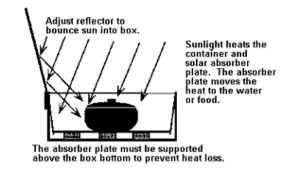
Although hundreds of innovative solar cooker designs have been invented, the solar box cooker is given the widest consideration due to its widespread global usage, particularly in the developing world.
A solar box cooker is basically a large box with a glass lid that will function as an oven. However, the heat losses over a larger surface area will partially offset the additional gain through having a greater heat collecting surface. What is usually done to compensate for this is that a glazed surface cover and reflectors are used to increase the apparent collector area. These reflectors can be made from a variety of materials and their primary purpose is to reflect sunlight through the glazing material and into the cooking space inside of the box.
The box cooker consists of some type of heat trapping enclosure, which usually takes the form of a box made of insulating material with one face of the box fitted with a transparent medium, such as glass or plastic. This enables the cooker to utilize the greenhouse effect and incident solar radiation cooks the food within the box. The insulating material allows cooking temperatures to reach similar levels on cold and windy days as on hot days, as well as having an added benefit of blocking any leakages that could potentially seep through and damage the cooker. A dark cooking pot is recommended for cooking as it absorbs the maximum amount of heat and allows for higher cooking temperatures.[8]
A good rule of thumb that indicates when the sun is high enough in the sky to allow for efficient cooking is when the length of one's shadow on the ground is shorter than that individual's height.
Parabolic solar cooker[edit | edit source]
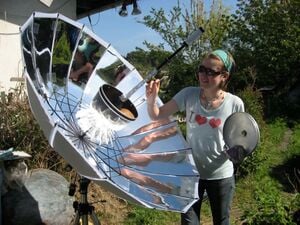
A parabolic solar cooker is essentially a solar energy concentrator used to cook food or pasteurize water. Parabolic designs have been used for centuries. The idea to concentrate light using curved mirrors was developed by the Greeks, Aztecs, Incas, Romans and Chinese. The Incas used bronze and gold for their mirrors and they built structures that were several stories high. This technology seems to have appeared around the same time for each of the civilizations.
There are many designs and models for parabolic solar cookers. Some are made with locally gathered scrap materials while others are manufactured using highly machined, durable but more expensive materials. Here are links to and photos of a number of parabolic solar cooker designs.
Solar funnel[edit | edit source]
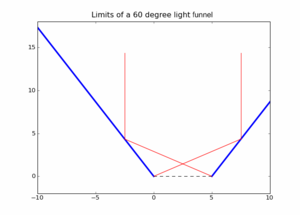
A solar funnel is the basis for many solar cooking designs. In it, light is funneled by flat reflectors to a pot or other surface to be heated which is located on the other end of the funnel. This differs from designs where the pot sits between the sun and the reflectors, as in most parabolic cookers. A solar funnel is the flat version of the more idealized Compound Parabolic Concentrator.
Compound parabolic concentrators[edit | edit source]

Compound parabolic concentrators (CPCs) are a class of concentrators that consist of rotated parabolic sections which have a concentration factor for planar receivers which is the thermodynamic limit: 1/sin(θa) where θa is one-half of the angle within which the reflectors direct all the light incident onto the aperture down to the receiver. Compound parabolic concentrators (CPCs) can be additions to solar water stills, solar water pasturizers, and solar cookers. CPCs can increase the output of these devices along with their efficiency by concentrating the sunlight to make the device more effective.
Recently research has shown that by incorporating compound parabolic concentrators (CPCs) for augmenting the light collection of a solar still[9] and a solar water pasteurizer,[10] the efficiency and throughput can be improved.
Integrated cooking[edit | edit source]
Integrated cooking combines the use of:
- An appropriate solar cooker model whenever the sun is shining;
- A retained heat cooker (hay basket or fireless cooker) to extend cooking time and keep food hot for 3-4 hours after cooking; and
- An improved cookstove (i.e. efficient cook stove) for use when there is not sufficient sunshine.
Alternative uses[edit | edit source]
Besides cooking, these devices can be used for other purposes. Some examples are
- Water pasteurization
- To disinfect dry medical supplies
- To sanitize utensils
Efficiency analysis[edit | edit source]

Here is an efficiency analysis of solar cookers based on the 1st Law of Thermodynamics and the 2nd Law of Thermodynamics, explaining also how to calculate the cooking power of any device.
Advantages[edit | edit source]
- In villages in regions such as Darfur, women have to travel less often to forage for firewood, thus keeping them closer to home and safe as a result.[11]
- Cheaper than cooking with firewood or charcoal.
- Reduced CO2 and methane emissions.
- Solar cookers can be easily constructed in a matter of hours after very basic training.
- Solar cookers are generally light-weight.
Health[edit | edit source]

The good news is that it is possible to breathe fresh air at the same time as cooking – using a solar cooker. Solar cooking produces no smoke at all.
In the past, the main reason for people adopting solar cooking was to reduce the environmental degradation caused by using too much fuel wood. More recently, respiratory diseases caused by toxic smoke from cooking fires have been recognized as a major health problem. They kill 1.5 million women and children each year, according to the World Health Organization (WHO). Solar cookers address these major threats to health as well.
Solar cooking technology has been around for decades, but has been poorly understood and has not been widely disseminated. Here are some ideas on what solar cooking is about, and its capabilities – as well as its limitations.
Disadvantages[edit | edit source]
- It can take very long to cook a meal.
- It is not always sunny.
- Solar cooking can only be performed when the sun is strong enough during mid-day, however hot food may be required much earlier on.
- Cooking has to be undertaken outside which may pose additional threats in developing countries.
- Will not perform well in windy areas.
- Can be inconsistent and may produce inedible food
- Solar cooking has an unexpected relationship with violence.[11] Anecdotes exist that solar cookers are not promoted by some NGOs in Africa due to domestic violence. When the weather has not been suitable for cooking, and the husband returns home to find no meal ready, he may become violent towards his wife. (This raises other issues, but one immediate issue is not to aggravate the victim's situation by having an unreliable cooker.)[verification needed] This failure of the meal to cook may have a technological solution: integrated cooking (see Wikia:Solarcooking:Integrated cooking method).
Related projects[edit | edit source]
Related organizations[edit | edit source]
Several Non-Government Organizations (NGO's) and private organizations have taken it upon themselves to promote the benefits of solar cooking in developing rural areas, from creating DIY designs to setting up training camps to educate villagers on how to build and cook with these devices. Several of these organizations have successful cooker designs already posted online, and others are in various stages of design. Some of these groups are listed below:
- Solar Cookers World Network. http://solarcooking.wikia.com
- Solar Cookers International. http://www.solarcookers.org/
- Kyoto Twist Solar Cooking Society. http://web.archive.org/web/20200928080713/http://kyototwist.org/
- Gadhia Solar Energy Systems Pvt. Ltd. http://solarcooking.wikia.com/wiki/Gadhia_Solar_Energy_Systems
- Solar Energy International. http://www.solarenergy.org/
- Centre for Rural Technology. http://web.archive.org/web/20050207224602/http://www.panasia.org.sg:80/nepalnet/crt/crthome.htm
- The Central American Solar Energy Project. http://solaroven.org/
- SUN OVENS International, Inc. http://www.sunoven.com
- Lazola-Initiative. http://www.lazola.de
Solar Cookers International[edit | edit source]
The overarching authority on solar cooking is Solar Cookers International (SCI). They spread solar cooking awareness and skills worldwide, particularly in areas with plentiful sunshine and diminishing sources of cooking fuel. SCI has enabled 30,000 families in Africa to cook with the sun's energy, freeing women and children from the burdens of gathering wood and carrying it for miles.
The Solar Cookers World Network is an alliance of more than 500 non-governmental organizations (NGOs), manufacturers, and individuals actively promoting solar cooking in more than 100 countries. This wiki-based site allows Network participants to share information and collaborate on projects and research. Solar cooking is an important part of Integrated Cooking, which also includes the use of fuel-efficient woodstoves and heat-retention cookers.
See also[edit | edit source]
- Solar Cookers, Efficient Stoves Help Rural Families Worldwide
- DIY solar thermal collectors
- Humboldt solar cooking gallery
- Stoves for Institutional Kitchens
- Green cooking
- Sun related calculations
- Using Two Parabolic Troughs to Simulate a Paraboloid
External links[edit | edit source]
- Wikipedia:Solar cooking
- Free and Easy DIY Parabolic Solar Concentrator Plan
- How to harness Sun's energy by making a solar concentrator
- https://twitter.com/JohnPaulGarland/status/1777739907651231812
References[edit | edit source]
- ↑ Solar Cookers International, "How to make a solar cooker", http://images3.wikia.nocookie.net/__cb20090108164302/solarcooking/images/5/57/CooKit_plans_detailed.pdf, Accessed April 6, 2010
- ↑ The Solar Cooking Archive, "Evaluating Solar Cookers", solarcooking.org/Evaluating-Solar-Cookers.doc, Accessed April 8, 2010
- ↑ The Solar Cooking Archive, "Evaluating Solar Cookers", solarcooking.org/Evaluating-Solar-Cookers.doc, Accessed April 8, 2010
- ↑ Solar Cookers International, "How to make a solar cooker", http://images3.wikia.nocookie.net/__cb20090108164302/solarcooking/images/5/57/CooKit_plans_detailed.pdf, Accessed April 6, 2010
- ↑ The Solar Cooking Archive, "Evaluating Solar Cookers", solarcooking.org/Evaluating-Solar-Cookers.doc, Accessed April 8, 2010
- ↑ Deutsche Welle, "Cooking with the power of the sun", http://www.dw-world.de/dw/article/0,,5205895,00.html, Accessed April 3, 2010
- ↑ The Solar Cooking Archive, "Evaluating Solar Cookers", solarcooking.org/Evaluating-Solar-Cookers.doc, Accessed April 8, 2010
- ↑ Wikipedia, "Solar cooker", http://en.wikipedia.org/wiki/Solar_cooker, Accessed April 3, 2010
- ↑ Joshua M. Pearce and David C. Denkenberger, "Numerical Simulation of the Direct Application of Compound Parabolic Concentrators to a Single Effect Basin Solar Still", Proceedings of the 2006 International Conference of Solar Cooking and Food Processing, p. 118, 2006. http://images.wikia.com/solarcooking/images/c/cd/Granada06_Joshua_pearce.pdf open access
- ↑ David C. Denkenberger and Joshua M. Pearce, "Compound Parabolic Concentrators for Solar Water Heat Pasteurization: Numerical Simulation", Proceedings of the 2006 International Conference of Solar Cooking and Food Processing, p. 108, 2006. Available: http://images.wikia.com/solarcooking/images/2/2e/Granada06_david_denkenberger.pdf
- ↑ 11.0 11.1 The points above come from email conversations. I hope to find get people with experience in these things to contribute to Appropedia. --Chriswaterguy · talk 00:20, 31 October 2007 (PDT)



